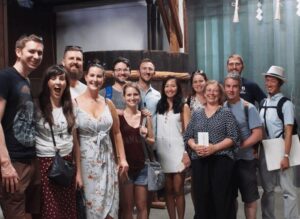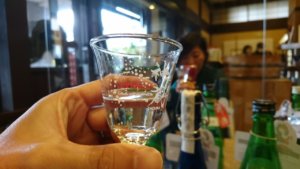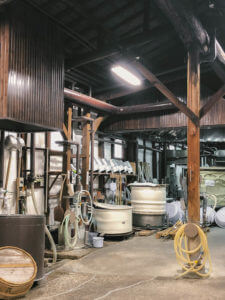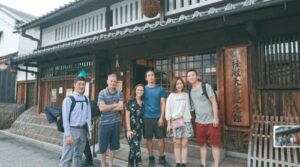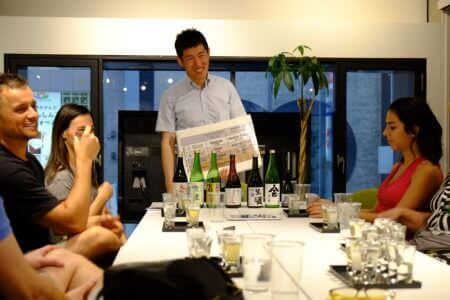This article is a continuation of the previous article.
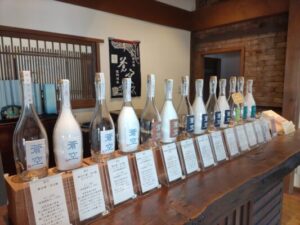
Heading for the Brewery Tour
First, we put on our lab coats and disposable caps in the room. We descended the stairs and walked through the store to the brewery located across the street from the store.
When you enter the brewery, the first thing you need to do is wash your hands and disinfect your hands, and change into slippers. The first thing I saw was a huge refrigeration room and empty bottles neatly lined up next to it. Fujioka Sake Brewery’s bottles are a little more rounded than most sake bottles. These bottles are made of Venetian glass imported from Italy.

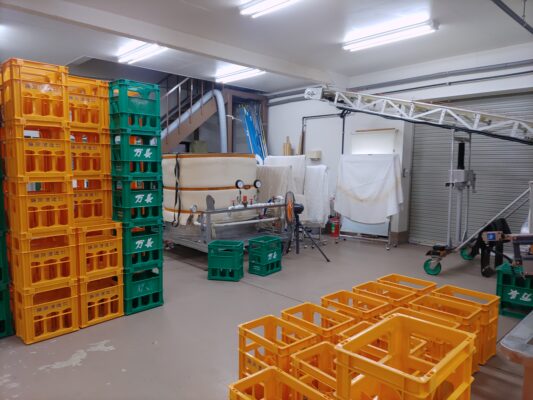
The content of a typical sake bottle is 720ml, but the content of this bottle is a little smaller at 500ml.
This bottle is a little smaller in size, 500ml, which is supposed to be just the right amount for a couple. Also, the shape of the bottle was designed to fit in the door pocket of the refrigerator. I felt that this kind of thoughtfulness is also reflected in the product.
Next to the empty bottles, there is a cute line of bottles containing light yellow-green liquid that are being hit by a fan. For a moment, I wondered what the bottles were for, since I had always imagined sake to be almost transparent. Juice? I thought.
I was told that this lime green color is the original color of sake. It is said that the color comes from the koji mold of the rice. However, Fujioka Sake Brewery does not use carbon filtration, so you can enjoy the original color of the sake.
Sake is sensitive to ultraviolet rays, so most sake bottles are colored in dark colors to protect them from UV rays.
However, Fujioka Sake Brewery uses a transparent bottle, which is rare for sake, so that you can enjoy the original color. The sake inside is, of course, sensitive to UV rays, so it is best to store it in a box and always in the refrigerator. (This also seemed to be one of the reasons why they were so particular about the size of the bottles.)
(This also seemed to be one of the reasons why they were so particular about the size of the bottle.) Incidentally, the reason why the bottle was hit by a fan was because if it was packed in a box right after being taken out of the refrigeration room, water droplets would form around it, so it was dried before being packed in the box for shipment.
Into the Producing Area
The next room was the manufacturing site! When you enter the room, you will see six large tanks and a koshiki (steamer).
First, the rice is washed and soaked. Soaking time varies depending on the weather, air temperature, humidity, and water temperature of the day.
At Fujioka Sake Brewery, the soaking time is measured for each 10kg of rice. The blackboard next to the scale is filled with detailed calculations.
After soaking, the rice is steamed in a koshiki (steamer) located behind the scale. When steaming the rice, the bottom of the steamer is covered with beads of pseudo-rice.
By doing this, the rice at the bottom does not get soggy and the moisture content is evenly distributed. I was impressed by the various ways they devise to make delicious sake.

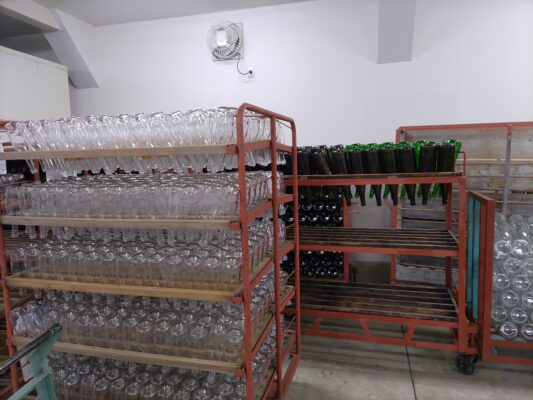
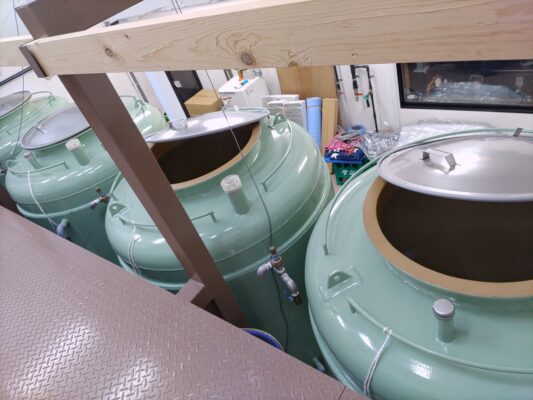
After steaming, the rice is mixed with brewing water that has been lowered to 1 degree Celsius to make it 6 degrees Celsius. After that, it is put into the production tank.
The large production tank has a capacity of 2500 liters. The temperature is kept at 6 degrees Celsius as much as possible.
The tank has a double-layered structure with a temperature sensor to prevent the temperature from rising above 10 degrees Celsius, and 4 degrees Celsius water is poured into the tank on the outside to control the temperature.
I got a peek at the tank from above. The tank was empty because it was not in the brewing season, but it was so big that I felt like I was being sucked in.
Next to the tank, we were shown the squeezer. The machine was located in a large refrigerated room. The finished mash was put into a squeeze bag and squeezed over a period of three days.
On the first day, the bags are lined up and squeezed without applying pressure to the weights.
On the second day, pressure is gradually applied.
On the third day, the bags are rearranged and pressure is applied again.
All the sake squeezed on the first three days is put into the same tank.
Drinking Sake Made with Love and Care.
After the sake has been squeezed for one to three days, it is put into the same tank.
The finished sake is bottled, labeled, and shipped. This bottling and labeling is all done by hand. The sake is bottled and labeled by hand, so there may be slight discrepancies, but that’s part of the flavor. I felt the warmth of the human touch in the spirit of the craftsman.
After this, there was time for a question and answer session, and the tour of the brewery ended. The tour took about one hour.
Afterwards, we went to the store and looked at the Fujioka Sake Brewery’s sake again. Normally, you can taste sake at the “Sake Bar En” attached to the brewery, but since we were in the middle of declaring an emergency, we decided to buy some sake and try it.
After hearing about Mr. Fujioka’s passion for sake, the sake we saw was even more interesting than the first time we saw it. After the tour of the brewery, I wanted to try every bottle! I wanted to try every bottle!
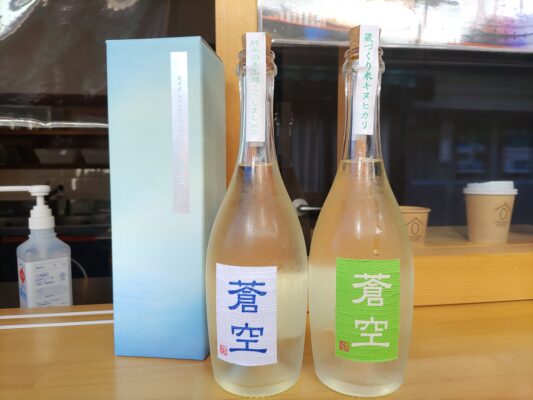
・Sokuu Kinuhikari – 蒼空 蔵造り米キヌヒカリ
・Sokuu Junmaishu Miyamanishiki – 蒼空 純米酒・美山錦こうじましましまし(試験醸造酒)
I bought these two bottles and left the Fujioka Shuzo with an excited feeling. By the way, both the bottle and the box it came in were very beautiful, the color of a clear sky.
When I got home, I tasted two of the bottles.
<Sokuu Kinuhikari – 蒼空 蔵造り米キヌヒカリ>
The first sip had a floral aroma and I thought it would not go well with a meal, but from the second sip, I could taste that it made me want side dishes such as meat and potatoes.
<Sokuu Junmaishu Miyamanishiki – 蒼空 純米酒・美山錦こうじましましまし(試験醸造酒)>
It seems that more koji rice is used in this bottle than usual. The aroma is a little sweet and sour, like yogurt. When you drink it, the slightly sweet and refreshing taste spreads to your mouth.
When I heard the origin of the name “Sokuu,” which means “a sake that makes you feel relieved when you see the blue sky at the end of the work day,” I had an image of a refreshing, light, and invigorating taste, but when I drank Fujioka Sake Brewery’s sake, I felt like I was talking about the feeling of relief you get when you spend time with your family after work. It made me feel warm inside.
For more information on Fujioka Brewery’s sake brewery tours, please check the website and make a reservation in advance.
Fujioka Shuzo Sake Brewery
Bar En Opening Hour : 11:30~18:00 | Close Wednesday
Require booking for sake brewery tour. Check Website for details http://www.sookuu.net/



